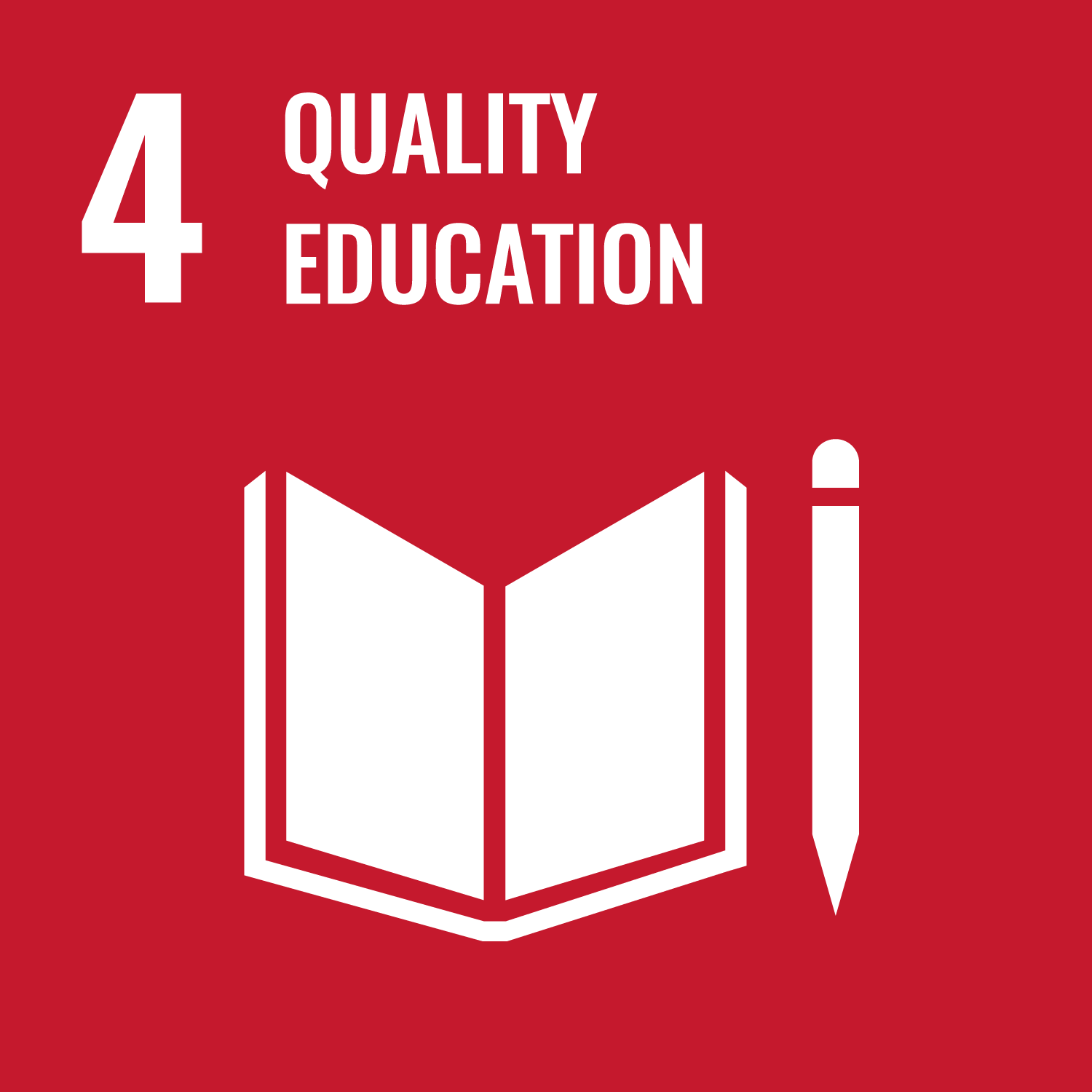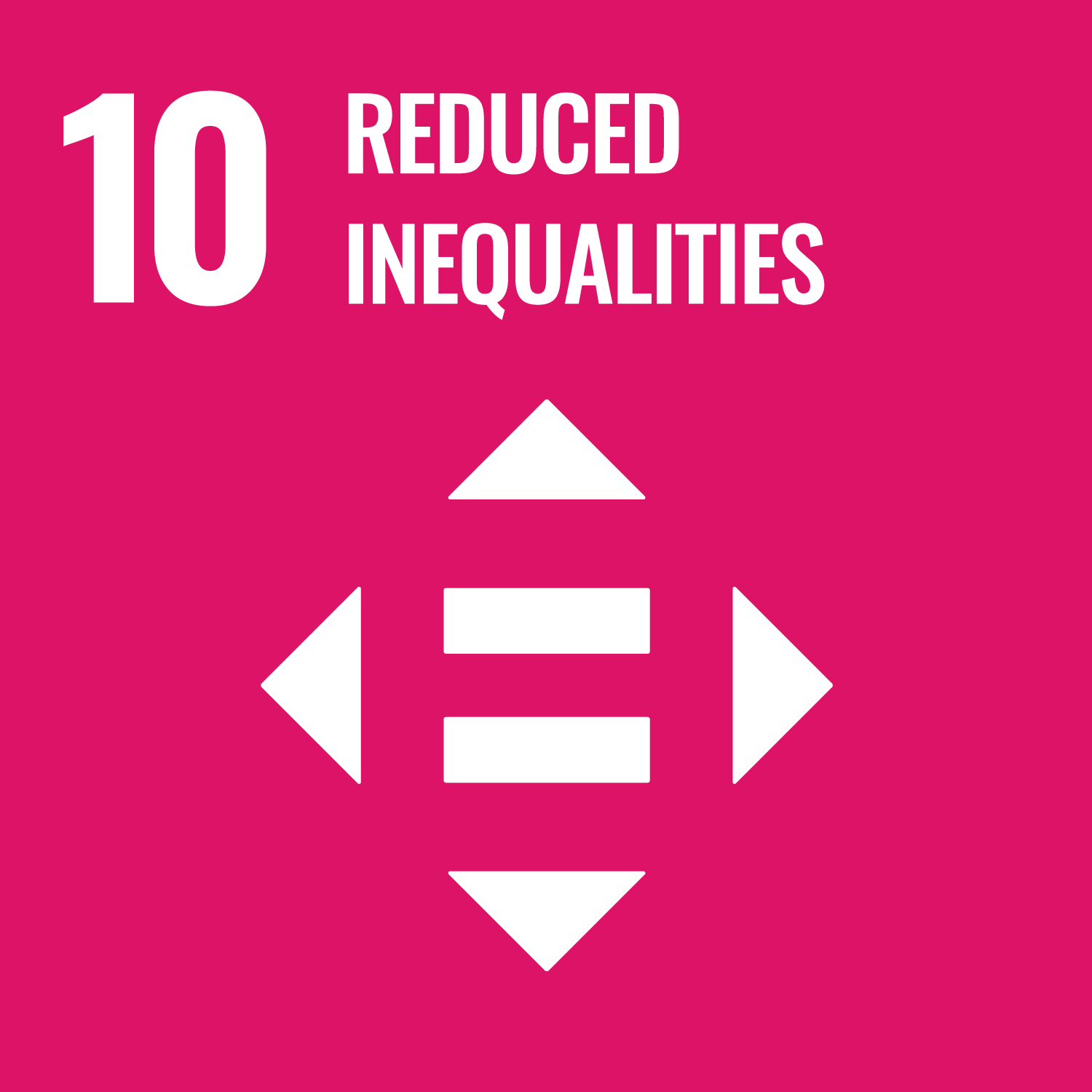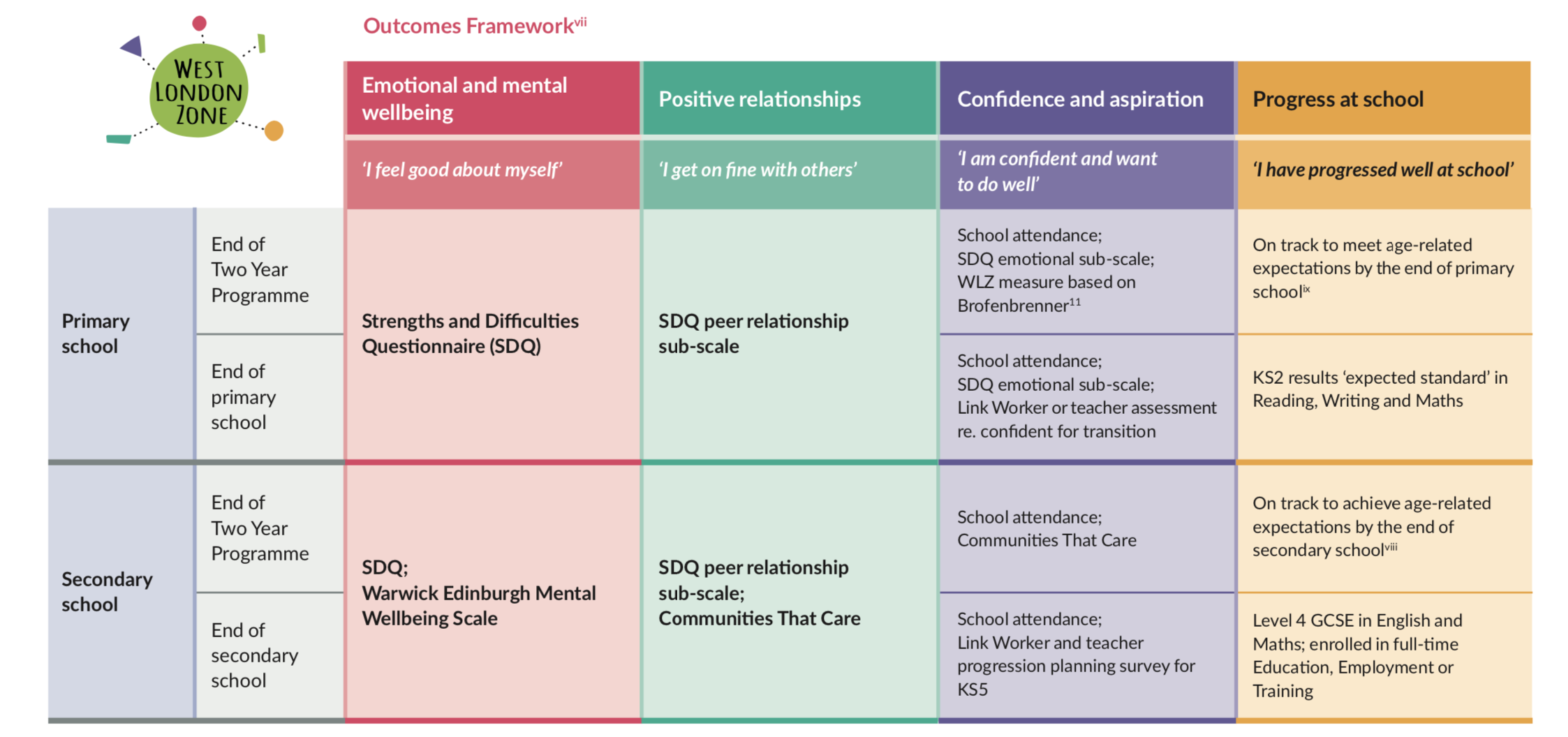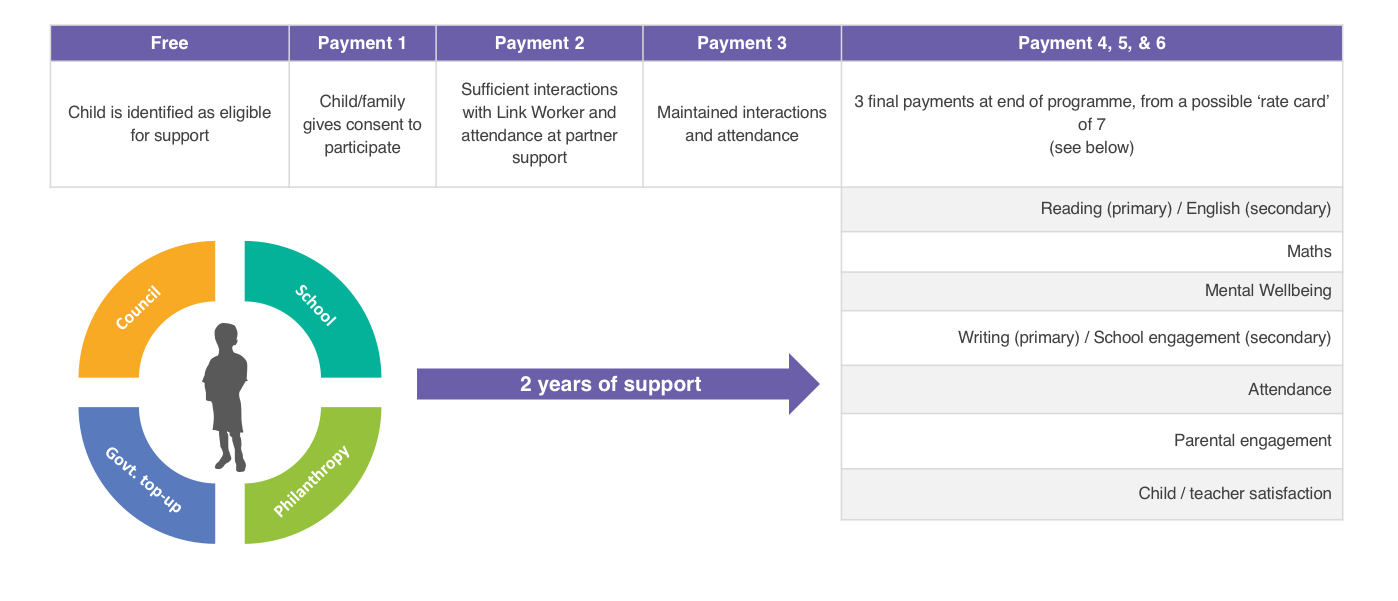
- Impact bond
- Education
- Health and wellbeing
- Child and family welfare
- UK
London, United Kingdom
5 mins
West London Zone
Last updated: 1 Oct 2019
WLZ designed a Collective Impact approach to leverage the local “social assets” around a shared vision. WLZ actively supports each partner and provides a Link Worker for each child, who builds a trusted, lasting relationship with the child and their family, helping them set their own goals for the future and working with charity partners on the ground to ensure that delivery is consistent and tailored to each individual.
Project Location
Aligned SDGs


INDIGO Key facts and figures
-
INDIGO projects
-
Commissioner
- Department for Culture, Media and Sport (DCMS)
- London Borough of Brent
- London Borough of Hammersmith and Fulham
- Other - Philanthropic contributions are included within the overall revenue of this project
- Royal Borough of Kensington and Chelsea
- The National Lottery Community Fund
- Westminster City Council
-
Intermediary
-
Investor
-
Provider
- ALLCHILD Limited (formerly 'West London Zone')
- Aldridge Academy
- And Circus
- At the bus
- Bevington Primary Art Brunel Academy
- Child Counselling
- Children's Literacy Charity
- Choose to Live
- Clement James Centre
- Coachbright
- Creative Futures
- Eastside Educational Trust
- Flourished Minds
- Future Men
- Hackney Speech and Language Therapy
- Hammersmith Community Gardens Association
- In your corner
- Jamie's Farm
- Kit Theatre
- Kite Studios
- Leap
- London Sports Trust
- Nourish Hub
- Number Champions
- Oasis Farm
- Place2Be
- QPR Community Trust (Queens Park Rangers)
- ReACT drama therapy
- Reclaimed
- Rugby Portobello Trust
- Team Up
- The Bike Guys
- Tie-Dye Drama
- Tutors Green
- Unlocking potential
- Urbanwise London
- West London Action for Children
-
Funds
-
Capital raised (minimum)
GBP 2.12m
(USD 1.53m)
-
Service users
2k+
The challenge
West London Zone is a collective impact initiative supporting young people in West London – a three-square mile area around Harrow Road in London. This area is home to around 66,000 young people aged 0 to 25. The Zone is deeply divided by wealth and life chances; it has some of the most prosperous neighbourhoods in the country, but also some of the most deprived areas.
West London Zone (WLZ) found that 20% of the children in the area exhibited risk factors such as social exclusion, educational disadvantage, and poor mental wellbeing, that could prevent them from living a happy and independent life if left unaddressed.
The solution
Together with their community, WLZ designed a Collective Impact approach to leverage the local “social assets” – such as charities, nurseries, schools, statutory services, and other community groups – around a shared vision. As the ‘backbone’ for this initiative, WLZ actively supports each partner and provides a Link Worker for each child, who builds a trusted, lasting relationship with the child and their family, helping them set their own goals for the future and working with charity partners on the ground to ensure that delivery is consistent and tailored to each individual. The support programme for each child lasts for 2 years.
In December 2017, the WLZ programme was extended to cover areas of deprivation in Kensington and Chelsea.
Read more about the WLZ model here.
The impact
Cohort One (2016-2018) Results: End of Two-Year Programme
- 85% of all participants engaged with their support to a high level (target 75%)
- 74% of maximum outcomes achieved (target 70%)
- 65% of children improved or met target for emotional and mental wellbeing
Cohort Two (2017-2019) Results: Mid-point of Two-Year Programme
- 89% of all participants engaged with their support to a high level (target 75%)
- 68% of children improved or met target for emotional and mental wellbeing
- 85% of children improved or met target for positive relationships
Find out more about the WLZ results here.
Outcomes framework
West London Zone worked with key local stakeholders and funders to develop an outcomes framework which captures the progress a young person is making towards flourishing in all areas of their life. The organisation took an iterative approach to developing the framework, to ensure that the outcomes measured can be linked to a robust payment mechanism, whilst also meeting the longer term aims of the programme.
The current framework covers a total of seven ‘outcome areas’ across four domains:
- Positive relationships
- Emotional and mental wellbeing
- Progress at school
- Confidence and aspiration
All seven outcome areas are measured and monitored for school-age children, but a lower number are measured and monitored in very young children and young adults as they are not all relevant. Each of the outcome areas has one or two measures which enable the monitoring to take place.
Further information about the WLZ outcomes framework is available here.
Payment mechanism
While the organisation tracks their impact across a broad set of long-term outcomes, payment for outcomes is linked to specific measures across the two years of support provided to each child on the programme, as outlined in the diagram below.


Development timeline
-
2013
Data collection and analysis, including consultation with children, young people and their families.
-
September 2014
Commissioning Better Outcomes funding application.
-
November 2014
Agreement with Triborough to share data and analyse the cohort of children for WLZ.
-
October 2015
1-year pilot of the operational model launched in North Hammersmith.
-
May 2016
Commissioning Better Outcomes Fund award of £1.2m announced.
-
September 2016
Pilot Implementation Study published.
-
September 2016
WLZ Collective Impact Bond is launched.
-
December 2017
WLZ expanded to North Kensington.
-
September 2018
24 schools and around 650 children enrolled on the programme.
Project insights
A collective impact project
WLZ is a place-based collective impact project, bringing together a range of organisations from schools to public services to charities, neighbourhood groups and private funders. Collective impact is a response to a common problem wherever multiple organisations seek to tackle complex social issues: sub-scale, isolated service delivery that ends up being somehow less than the sum of its parts.
This collaborative approach underpins the unique finance model used to fund the project – a Collective Impact Bond. This brings together funding from local authorities, schools and private philanthropists, topped up by central government and Big Lottery funding. Payment is only released when each individual child engages with the programme throughout their two years and makes measurable progress at the end, ensuring that even the most challenging participants engage. WLZ is currently exploring how to bring the philanthropy component of the CIB onto an outcomes-based model.
WLZ acts as the backbone organisation for a suite of delivery partners. They are a diverse group of organisations with expertise in the core areas needed to support the strengths and needs of the cohort of children that WLZ supports. Some are very local to the Zone and have been involved in the early stages of co-designing the WLZ model, whereas others are large national charities or new social enterprises. All are different, with their own expertise, characteristics, delivery models and progress measurement methods. While WLZ is paid on an outcomes-basis through the Collective Impact Bond, delivery partners are paid on a fee-for-service basis.
Read more about WLZ's funding model.
Defining measurable outcomes
Because of the inherent complexity of the problems they are seeking to address, collective impact initiatives tend to try to achieve multiple outcomes, that are in turn underpinned by many indicators.
However, as payment is directly linked to outcomes in the WLZ funding model, outcomes had to be identified that can be reliably measured, monitored and attributable to the programme. In practice this required in the early stages of the project ongoing reviewing and refining of the outcomes framework.
The framework now covers four outcome areas – positive relationships, mental wellbeing, progress at school, and confidence/aspiration – with 7 specific measures (related to those 4 areas) which can release payment at the end of each child's two year programme.
Data collection & analysis
Data is a central pillar of the WLZ model, as it is through the collection of accessible, accurate, consistent and protected data that West London Zone’s impact on the lives of young people can be tracked, measured and communicated.
West London Zone makes use of data for a number of operational purposes:
- to help track students’ progress towards outcomes
- to drive evidence-based decision-making by management and other stakeholders
- to help deliver new insights to help test, improve, and refine policies and practices.
To ensure a robust monitoring of a young person's progress, WLZ collects data at regular time points from a range of sources:
- WLZ data collection survey (composite of self-report measures on a wide range of health, wellbeing, character and non-academic progress measures; the survey measures 19 additional risks in addition to school data) – Annually in October
- School administrative data (demographic information, attendance – Annually in October
- Delivery partner data (weekly attendance, pre- and post- programme outcome measurement) – Weekly
- Link worker engagement notes (qualitative reporting on young people's engagement and progress) – Daily
To enable this data to be meaningful, WLZ worked with Dartington Service Design Lab to develop a data system that enables data to be collected from all four sources, merged into a single database, and presented visually in the form of ‘dashboards’.
- to help track students’ progress towards outcomes
Contact details
For further information on the West London Zone project, you can contact Freddie O'Farrell, Development Officer at West London Zone.
References
Communication with Freddie O'Farrell, Development Officer at West London Zone, 2018.
West London Zone website, 2018.
Summary of the West London Zone Pilot Implementation Study, 2016.
Page last updated: October 2019.
Downloads and Resources
Summary of the West London Zone Pilot Implementation Study
Download PDFAn in depth review for CBO: West London Zone
Download PDFWLZ - Data Template
Download XLSXWLZ Collective Impact in Practice Report 2018
Download PDFCommissioning Better Outcomes Evaluation - Final Report 2022
Download PDF